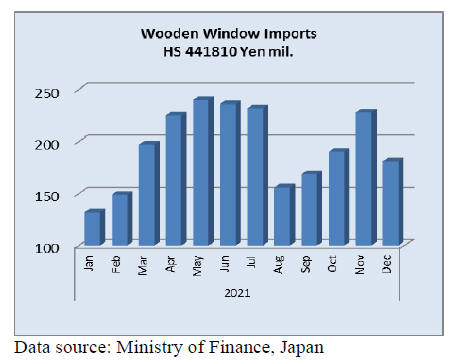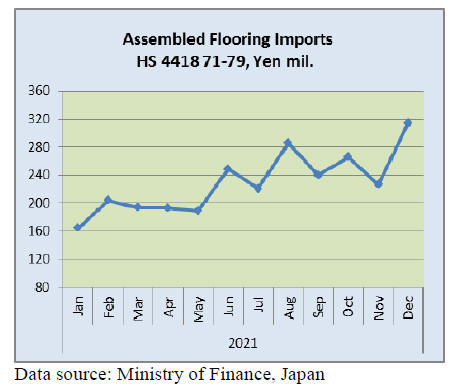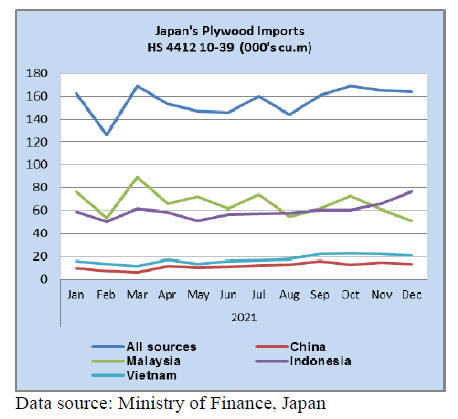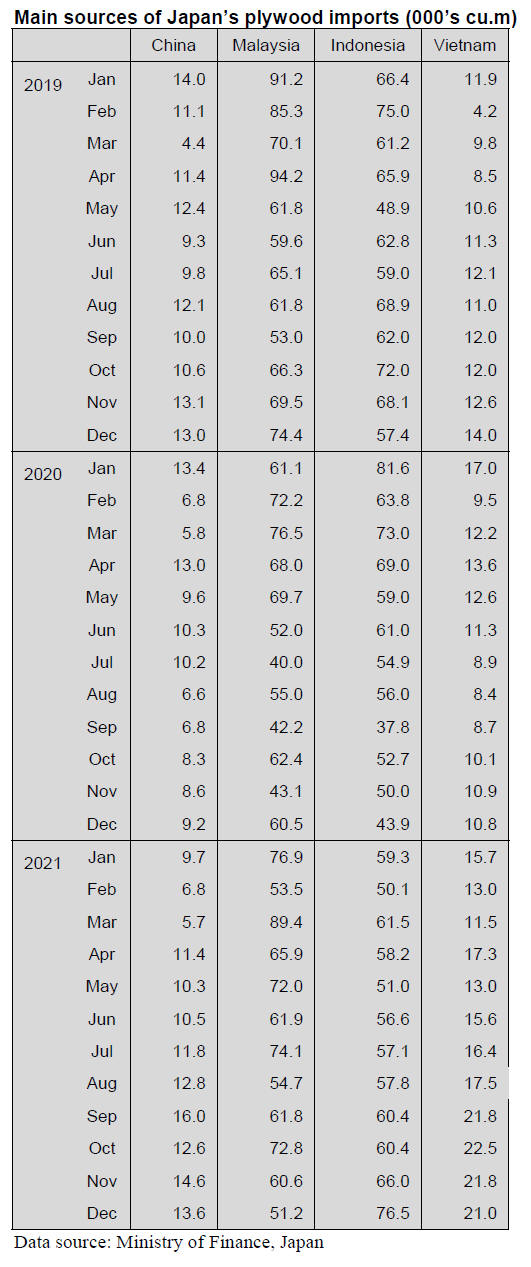Japan
Wood Products Prices
Dollar Exchange Rates of 25th
Feb
2022
Japan Yen 115.54
Reports From Japan
Supply problems affect factory
production
An article prepared for Seeking Alpha by IHS Markit
discusses the issues driving the February Jibun Bank
Manufacturing PMI which was at 52.9 down from 55.4 in
January. Factory production levels fell in February in
response to supply chain problems and these had a knockon
impact on producer input prices which jumped to the
highest level in over a decade.
Seeking Alpha says ¡°The biggest drag on the headline
PMI in February was a fall in manufacturing output, as the
Omicron wave of the COVID-19 virus disrupted
production and supply chains¡±.
See:
https://seekingalpha.com/article/4488809-japanmanufacturing-output-falls-prices-rise-amid-worsening-supplysituation
Consumer spending dips
In mid-February the government lowered its assessment of
prospects for the economy noting that consumer spending
has dropped. This downgrade was the first in five months.
Prospects for residential construction was also
downgraded on the basis of fewer housing starts. On the
other hand prospects for business investment were
upgraded.
The government warned of risks from the impact of the
Omicron variant, supply-chain disruptions and rising rawmaterial
costs. This report was published before Russia
began what appears to be a full scale invasion of Ukraine.
See:https://www3.nhk.or.jp/nhkworld/en/news/20220218_25/
Businesses wary of economic security legislation
The government will soon introduce legislation to
strengthen the country¡¯s economic security. This has
received mixed reaction from the private sector. While
recognising the importance of economic security business
leaders are concerned that government intervention may
disrupt business activities.
The economic security bill is expected to address four
issues:
security of key infrastructure
supply chain stability
public-private development of new technologies
securing patents on sensitive technologies
Businesses are aware this will result in a burden on
them.
For example the government is expected to require
companies in certain sectors to report on plans to install
infrastructure management systems identifying the
suppliers so they can be screened.
See:
https://www.japantimes.co.jp/news/2022/02/14/business/economic-security-law-business-worries/
Russia sanctioned
Japan imposed economic sanctions on Russia and two pro-
Russian separatist regions in Eastern Ukraine after Russia
recognised these two areas as independent and ordered
troops to invade. Japan has condemned the latest Russian
attacks on Ukraine as a violation of the sovereignty and
territorial integrity of the country as well as international
law.
As a result of further Russian aggression Japan joined the
US and European countries in imposing additional
sanctions. Russia is the second largest sawnwood supplier
to Japan after the EU. There is no news as yet on whether
this trade will be affected by Japanese sanctions or
retaliation by Russia.
Energy prices a 41 year high
Consumer inflation rose in January from a year earlier as
energy prices rose to the highest in 41 years. The Ministry
of Internal Affairs says the Consumer Price Index,
excluding fresh food, was up 0.2% in January from a year
earlier. The index rose for the fifth straight month.
Gasoline was up 22%, electricity bills rose 15.9% and gas
prices rose almost 18%. Overall, energy prices surged 17.9
percent, the biggest jump since January 1981 when Japan
faced its second oil crisis.

Housing starts
From a peak in October housing starts in Japan have been
steadily falling. Construction activity always slows during
the Japanese winter and the January housing starts data are
much the same as in January 2020.

Expect currency volatilty
The US dollar jumped to its highest level in nearly two
years and the Russian rouble plunged to a record low after
Russia launched an invasion of Ukraine as investors fled
to ¡®safe-haven¡¯ assets.
Against other ¡®safe-havens¡¯ the dollar rose 1% against the
Swiss franc while the Japanese yen weakened 0.52%
against the US dollar to over just 115 per dollar.

Import update
Trends in imports of builders¡¯ woodwork and plywood are
illustrated below. There was a modest recovery in imports
in 2021 compared to a year earlier for wooden doors,
assembled flooring and plywood. Yet to catch up is
imports of wooden windows the value for which still
hovers at 2020 level.
However, it was only imports of assembled flooring that
edged a little higher compared to levels in pre-pandemic
2019. The value of wooden door and wooden windows
and the volume of plywood imports still have a way to go
to get back to pre-pandemic levels.
A remarkable feature of the illustrations below is that
manufacturers in China and ASEAN countries dominate
Japan¡¯s imports of the featured products.

December wooden door Imports (HS441820)
In December shipments of wooden doors (HS441820)
from China accounted for 53% of all Japan¡¯s wooden door
imports. The other main shippers in December were the
Philippines (29%) and Indonesia (8%).
Year on year, December 2021 wooden door imports were
10% higher than in 2021 but 31% higher than in
November 2021. The rise in December 2021 imports of
wooden doors marked a major turning point in the year
after a clear downward trend.

December wooden window imports (HS441810)
Up until the December 2021 decline the value of Japan¡¯s
wooden door imports (HS441810) had been steadily
rising since August 2021 to reach a high in November of
the same year.
The correction arrived in December 2021 when compared
to the value of November imports there was a 21% decline
in December. Year on year, December 2021 imports were
10% down. Around 46% of wooden window imports came
from China with a further 22% from the Philippines and
12% from Sweden.

December assembled wooden flooring imports
The value of Japan¡¯s assembled wooden flooring imports
(HS441871-79) have steadily trended upwards from May
2021 and the rise in December 2021 which was more
noticeable than in previous months has added to this
upward momentum.
The main category of assembled flooring imported by
Japan is HS441875 accounting for around 74% of
December 2021 imports with the main suppliers being
China and Vietnam and Malaysia. The second ranked
category in terms of value of imports was HS441879
shipped mainly from China, Thailand and Vietnam.
Compared to December 2020 imports of assembled
wooden flooring more than doubled in December 2021
and compared to a month erlier, December imports
jumped 38%.

December plywood imports
In the last quarter of 2021 Japan¡¯s imports of plywood
have risen sharply as the country experienced a surge in
demand for plywood and was unable to meet this demand
from milling domestic logs. Year on year, the December
2021 volume of imports of plywood (HS441210-39)
jumped 30% but there was little change in the volume of
imports compared to November.
Indonesia and Malaysia dominate the supply of plywood
to Japan and in December shipments from Indonesia rose
compared to a month earlier but shipments from Malaysia
dropped.
Of the various categories of plywood imported in
December 2021(as in other months) HS441231 was the
most common accounting for almost 90% of imports.


Trade news from the Japan Lumber Reports (JLR)
The Japan Lumber Reports (JLR), a subscription trade
journal published every two weeks in English, is
generously allowing the ITTO Tropical Timber Market
Report to reproduce news on the Japanese market
precisely as it appears in the JLR.
For the JLR report please see:
https://jfpj.jp/japan_lumber_reports/
Total wood product imports in 2021
Here is a result of imported logs, lumber, boards and
construction laminated lumber in 2021. The total volume
of all categories is 4.7% more than 2020. It is recovering
slightly from 2020¡¯s result. People had attention on
volume of imports from North America, Europe and New
Zealand because the 3rd wood shock occurred in Japan.
The grand total of logs is almost 18% increased because
logs imported from Canada increased. The grand total of
lumber is just only 4% decreased, not as much as people
were concerned about an influence on confusions of
delayed containers.
The delivery of plywood was good but construction
laminated lumber decreased nearly by 9%. People had
worried about the volume of imports would be over 10%
decreasing due to the 3rd wood shock, but it did not.
The volume of Douglas fir logs from North America
increased 25% from 2020. However, lumber was as same
as 2020¡¯s. Since demands in the U.S.A. were lively, the
exporting Japan decreased. There are negative factors like,
supply companies were limited, a natural environment had
changed and there were problems of labors at ports.
The volume of logs from the U.S.A. were almost as same
as last year. However, the logs from Canada increased
instead of the U.S.A. It was 460,000 cbms increased. Total
volume of logs and lumber from Canada to Japan were
more than the U.S.A. as a result.
Lumber from Europe decreased 7.2%. One of reasons is
that time lag from contracts and actual ariivals is longer
and unpredictable. Construction laminated lumber
decreased by 9%, but it is nearly the average volume
during 2017 and 2019 so it is not a bad situation.
Logs from New Zealand and lumber from Chili were
almost same volume as 2020¡¯s. However, the importing
costs in Japan could change easily by the prices of logs for
China from New Zealand.
Tropical hardwood plywood and Russian logs became a
level of 20,000 ¨C 30,000 cbms. This is due to export
restrictions in Russia and less demands in Japan.
The volume of imported plywood increased about 19%
even though people in Japan were anxious about not
enough volume. MDF was only 2 % decreasing although
there were a lot of demands in overseas and confusion on
transporting. OSB seemed growing market but there was a
limit of supplying in overseas.
South Sea logs and lumber
Not only logs but also supply in Japan is still low. The
lumbering companies in Japan have a difficulty in
producing due to a delay which caused by a lack of
containers. There is another reason such as not enough
trucks. However, lumbering companies in Japan control on
balancing product and demand even though the situation is
difficult.
Malaysia and Papua New Guinea are in rainy season so
the volume of shipping is low. It is not easy to book
vessels because demands in Japan are not much. Some
Japanese lumbering companies try to buy South Sea logs
from Taiwan but the importing costs are high.
People are hopeless for the volume of imported South Sea
logs from Sabah, Malaysia. The demand will be stayed
low in this year as well as last year.
Movements of South Sea hardwood lumber from China
had calmed down. There are enough inventory so new
orders have settled down in Japan. However, the prices in
South Asia are still high because of the prices of red pine
lumber from Russia and freights in China.
The movement of South Sea hardwood lumber would be
slow due to a lack of trucks in South East Asia.
Demand for South Sea hardwood logs in Japan would stay
low for all through this year. Movement of Chinese made
laminated free board has been quiet. Red pine lumber
prices are US$1,030-1,050 per cbm C&F. Indonesian
mercusii pine lumber prices are US$960-990 per cbm
C&F.
Use of domestic lumber for housing
Wooden Home Builders Association of Japan announced
use of domestic lumber in 2020 of housing companies.
48.5% of domestic lumber were used. The investigation in
2017, which was as last time, was 46.2%. 2.3% increased
at this time. This is the highest percentage in past six
times. Domestic laminated cedar lumber and LVL
increased a lot. The investigation was started in 2006, and
held in every three years.
49.5% of domestic lumber were used as pos. It was 41.5%
at last time. It is increase for three straight times.
Laminated cedar lumber was 30.9%. It was 20.7% in last
survey. Laminated redwood lumber was 36.6%, 40.3%
was the last time and laminated whitewood lumber was
13.8% decreasing from 17.2% in 2017.
It was 74.6% used for foundation and increased from
69.4%. Share of KD cypress was 44.2% increased from
38.6% last time. Beams of domestic species decreased to
9.2% from 9.8% in last time. Douglas fir was 19.3% and it
was 24% last time.
Laminated redwood beam lumber 52.9% decreasing from
54.1% but laminated whitewood increased to 9.2% from
4.7% in 2017. Stud from domestic species were 71.9%
increased from 56.6%. Especially, LVL were 36.6%
jumped from 0.3%. Brace was 17.6% and small sized
lumber was 48% increasing from 43.9%.
Laminated cedar lumber was 34.8% increased from
29.6%. Laminated whitewood lumber was 11.4%
increased from 8%.
North American log market
The suppliers¡¯ log purchase prices in January climbed by
about US$300 compared to last December prices so the
increase of export prices would be certainly up but steep
price increase at one time is hard for the buyers in Japan
so it is reported that February FAS prices on IS sort are up
by US$125 a tUS$1,275 per M Scribner.
With progressing trend of depreciation of the yen, import
cost would be up by 3,000 yen per cbm CIF and with
recovery of lumber of 50%, lumber cost would be up by
about 6,000 yen per cbm. Douglas fir lumber
manufacturers in Japanese are not ready to increase the
sales prices in February yet but the supply side are likely
to increase FAS prices in March to recover the difference
but this is just guess.
Assuming FAS prices go up by US$175 in March,
Douglas fir lumber manufacturers may be forced to
increase the sales prices. It all depends on how log market
and lumber market in North America change at the time of
March log price negotiations.
Future market prices of competing imported redwood
laminated beam is down to 125,000 yen per cbm FOB
truck port yard so Douglas fir lumber mills are worried
about narrowing price difference with redwood laminated
beam.
Douglas fir log prices for plywood mills are related with
Douglas fir log prices for sawmills. If the prices climb
same as sawlogs, February prices would be over US$250
per cbm CIF, which costs over 30,000 yen.
|